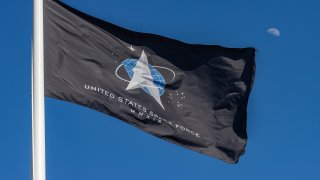Peter Garretson

Now that Congress is well on its way to creating a stand-alone legislative liaison for the United States Space Force (USSF), it’s time for them to give America’s newest military branch its own voice as well, in the form of an independent public affairs capability.
That would be a drastic change to the prevailing state of affairs, in which the Space Force’s messaging to the Hill and the American public is currently part of a combined shop under the Department of the Air Force. The result is deeply suboptimal. As retired Air Force General Simon “Pete” Worden said recently, “there is still too much interference from the Air Force.”
Creating a distinct messaging capability for the Space Force should consequently be a top priority for several reasons.
First, the Space Force must be able to tell the “military space” story. It needs to be able to create allies and supporters within the American electorate and reinforce efforts by the service to recruit and communicate its message. It also needs to be an integral part of shaping the operational environment, which includes allies, adversaries, and private industry—something a public affairs capability subservient to the Air Force simply can’t accomplish.
Secondly, the Space Force truly has a distinct message. Trying to reconcile it with that of the Air Force will effectively set back the development of spacepower. Since the USSF is new, it especially needs a dedicated public affairs office to explain precisely to the populace what it is doing and why.
Third, space is an enormously technical undertaking that demands a certain public affairs expertise. A Space Force public affairs officer needs not only to understand Space Force technology but also to be able to explain it to laypeople. The suite of technology, acronyms, and actors are almost completely different from those within the service’s former home, the Air Force.
Fourth, space is a rapidly changing domain, and the Space Force needs a public affairs office capable of moving just as quickly. The Air Force’s “comms,” by contrast, are slower, more methodical, and more plodding.
Lastly, a separate Space Force public affairs capability removes the potential for conflicts of interest and institutional wrangling within the Department of Defense. The Space Force’s interests are not the same as those of the Air Force, and certainly not the same as those of the Department of the Air Force. Congress gave the Department of the Air Force temporary stewardship of the Space Force, but the intent of both Capitol Hill and the White House was to move it to a separate department.
That’s something the Air Force is loath to do for obvious reasons. It benefits from keeping the Space Force as an attached organic support arm in both material and political terms. As such, the Air Force will naturally argue that both it and the Space Force fall under one secretary. But the discrepancy is glaring; at present, the Space Force is the only service branch without its own public affairs capability. (While the Marine Corps is formally under the Department of the Navy, it has its own very effective public affairs office with its own PA doctrine.)
As a growing number of experts have noted, “It’s high time we start messaging correctly about these professionals of our armed forces and communicate the reality of the threats to our way of life they are dealing with at exceptional cost and sacrifice on a daily basis.” If Congress wants to get the straight scoop on the Space Force, and if it wants the American public to properly understand—and embrace—the new service, it will need to move quickly to create a separate and distinct messaging capability for the military branch tasked with securing our interests in space.
No comments:
Post a Comment